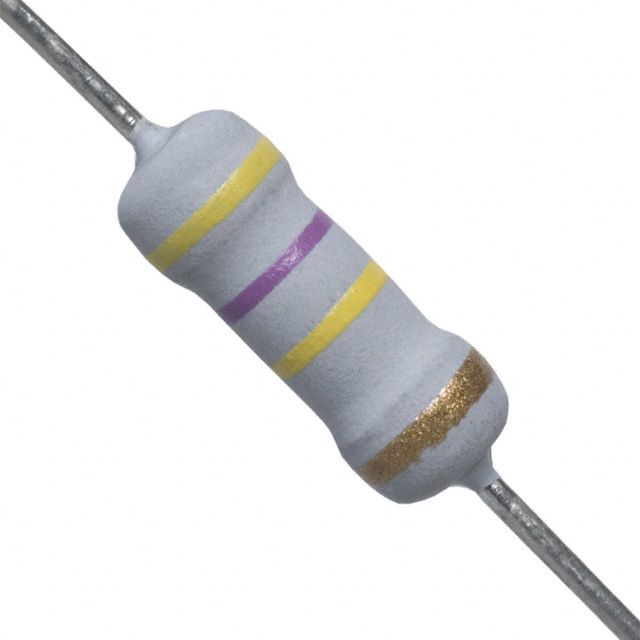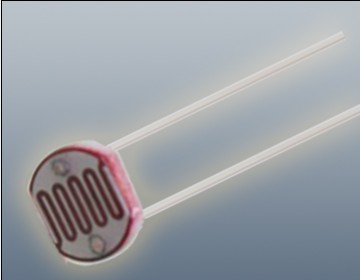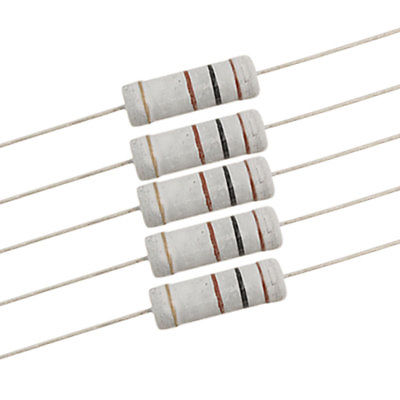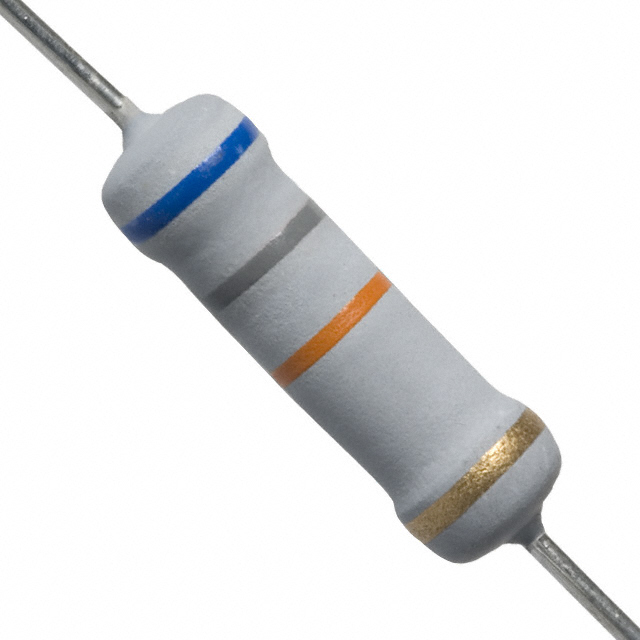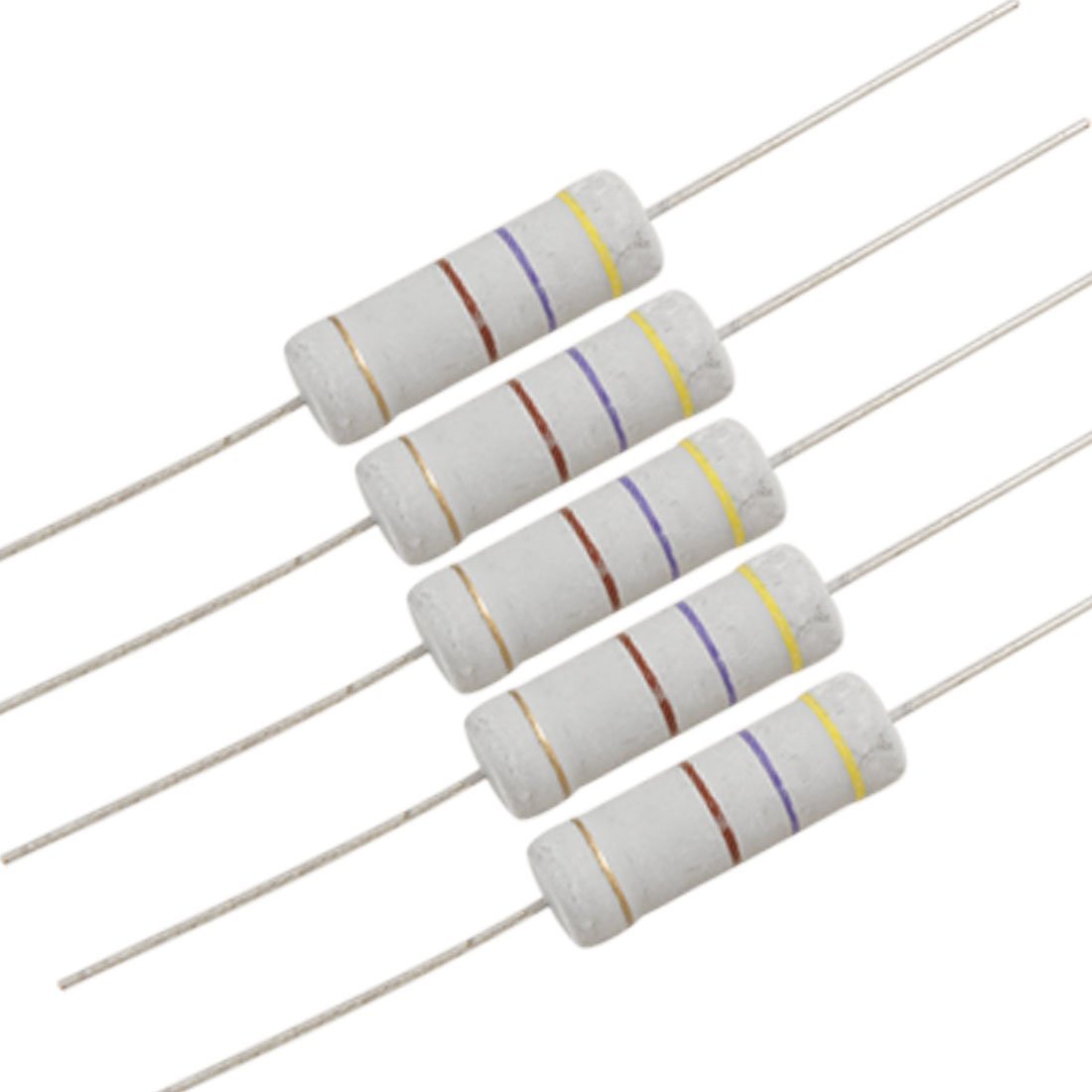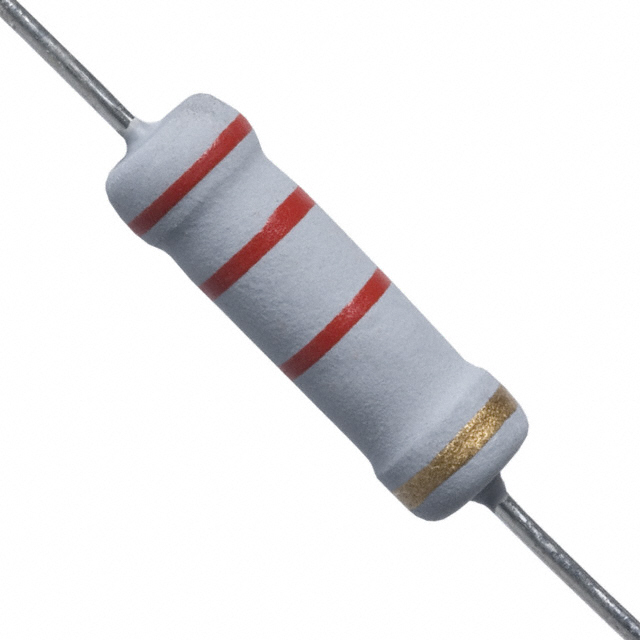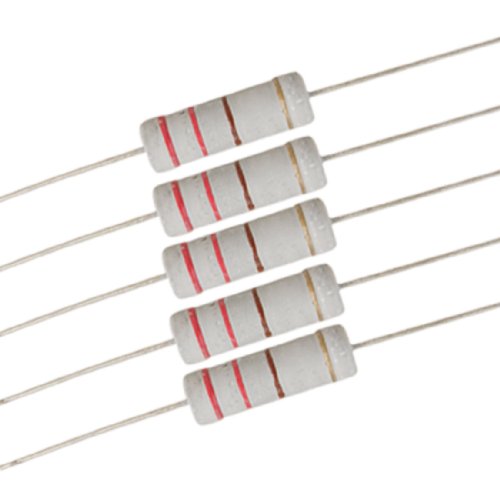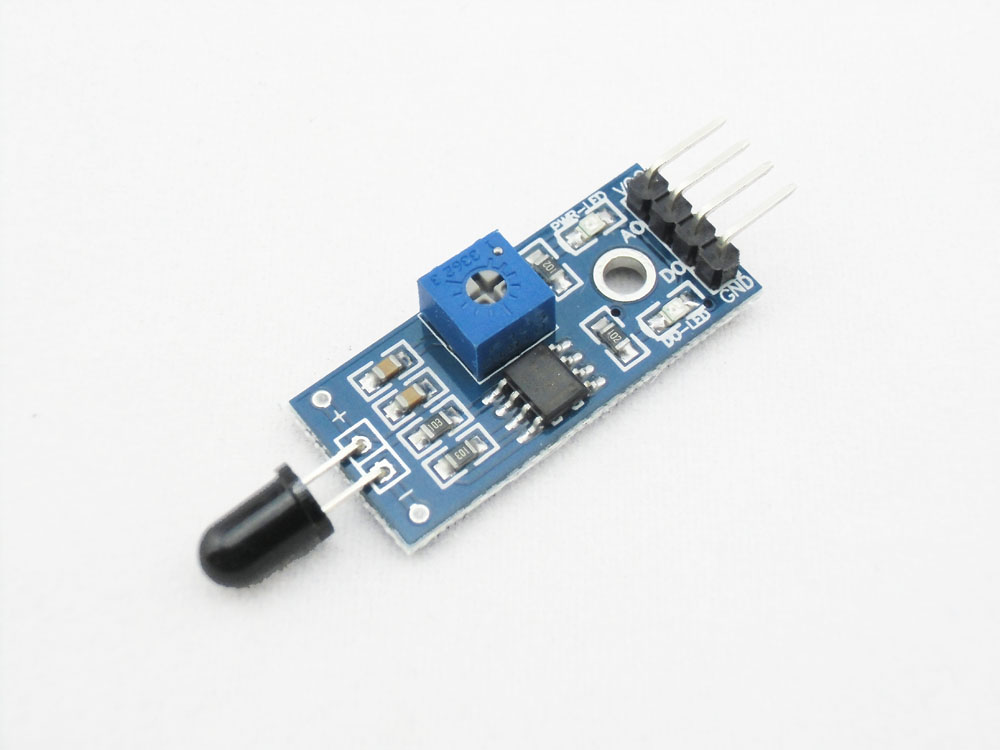|
Description |
The 22KΩ 2W resistor is a fixed-value resistor designed for applications requiring higher power dissipation and moderate resistance. It is used in various electronic circuits to limit current, divide voltage, and stabilize signals. The resistor’s robust design ensures reliable performance in both standard and high-power applications.
Key Features:
- Fixed resistance value of 22KΩ
- Power rating of 2 watts
- Flame-resistant coating for safety
- High stability and durability
- Axial leads for easy mounting on printed circuit boards (PCBs)
- Suitable for use in high-power and precision applications
Technical Specifications:
- Resistance Value: 22KΩ
- Power Rating: 2W
- Tolerance: ±5% (J) or ±1% (F), depending on the model
- Temperature Coefficient: ±200 ppm/°C
- Operating Temperature Range: -55°C to +155°C
- Body Size: Approx. 4.5mm (Diameter) x 14.5mm (Length)
- Lead Diameter: Approx. 0.8mm
- Material: Metal oxide film or carbon film
- Maximum Working Voltage: 350V
- Maximum Overload Voltage: 500V
Applications:
- Signal Processing: Ideal for use in circuits for signal conditioning and noise filtering.
- Voltage Dividers: Commonly used in voltage divider networks in electronic circuits.
- Power Supply Circuits: Applied in power supply circuits to regulate and limit current.
- General Electronics: Suitable for various electronic devices and circuits requiring higher power dissipation.
Usage:
- Identify the resistor’s resistance value and power rating by reading the color code or label.
- Solder the resistor onto the PCB or integrate it into the circuit using the axial leads.
- Ensure proper placement for effective heat dissipation.
- Verify the resistor’s connections and test the circuit to ensure correct operation.
Caution:
- Do not exceed the resistor’s maximum power rating to avoid overheating and damage.
- Ensure good ventilation and heat dissipation in high-power applications.
- Handle with care to avoid damaging the resistor’s leads and coating.
- Confirm the resistor’s resistance value and tolerance before use in precision applications.
|
The 470KΩ 1W resistor is a fixed-value resistor designed for applications requiring moderate power dissipation. It is used to limit current, divide voltage, and protect components in various electronic circuits. This resistor is suitable for high-impedance circuits, signal conditioning, and applications where precision and reliability are essential.
Key Features:
- Fixed resistance value of 470KΩ
- Power rating of 1 watt
- Flame-resistant coating for safety
- High reliability and stability
- Axial leads for easy mounting on printed circuit boards (PCBs)
- Suitable for high-impedance and signal processing applications
Technical Specifications:
- Resistance Value: 470KΩ
- Power Rating: 1W
- Tolerance: ±5% (J) or ±1% (F), depending on the model
- Temperature Coefficient: ±200 ppm/°C
- Operating Temperature Range: -55°C to +155°C
- Body Size: Approx. 4.0mm (Diameter) x 11.5mm (Length)
- Lead Diameter: Approx. 0.6mm
- Material: Metal oxide film or carbon film
- Maximum Working Voltage: 250V
- Maximum Overload Voltage: 400V
Applications:
- Signal Conditioning: Used in circuits to control and adjust signal levels.
- High-Impedance Circuits: Suitable for high-impedance applications and input stages.
- Voltage Dividers: Ideal for use in voltage divider circuits.
- Audio Equipment: Used in audio equipment for biasing and signal conditioning.
- General Electronics: Suitable for a variety of electronic devices and circuits.
Usage:
- Identify the resistor’s resistance value and power rating by reading the color code or label.
- Solder the resistor onto the PCB or connect it into the circuit using the axial leads.
- Ensure the resistor is placed in a location that allows for adequate heat dissipation.
- Verify the resistor’s connections and test the circuit to ensure proper operation.
Caution:
- Do not exceed the resistor’s maximum power rating to avoid overheating and potential failure.
- Ensure proper ventilation and heat dissipation when using the resistor in high-power applications.
- Handle with care to prevent damage to the resistor’s leads and coating.
- Verify the resistor’s resistance value and tolerance before use in precision circuits.
|
The Photoresistor LDR (Light Dependent Resistor) is a variable resistor whose resistance changes with the light intensity that falls upon it. It is widely used in light sensing applications and projects where detecting light levels is essential. LDRs are cost-effective, easy to use, and suitable for various electronic projects, including light meters, street lights, and other light-sensitive devices.
Key Features:
- Light Sensitivity: Resistance decreases with increasing light intensity
- Simple Interface: Easy to integrate with microcontrollers and analog circuits
- Low Cost: Economical solution for light detection
- Wide Range of Light Detection: Can detect various light levels from low to high intensity
- Compact Size: Fits easily into small projects
Technical Specifications:
- Resistance in Darkness: Typically 1MΩ (depending on specific model)
- Resistance in Bright Light: Typically 10-20kΩ (depending on specific model)
- Spectral Peak: Approximately 540nm (most sensitive to green light)
- Response Time: Rise time ~20ms, fall time ~30ms
- Operating Temperature Range: -30°C to +70°C
- Diameter: Typically 5mm to 10mm (depending on specific model)
Applications:
- Light Meters: Measure light intensity for photography and scientific applications.
- Street Lights: Automatic on/off control based on ambient light levels.
- Alarm Systems: Detect changes in light levels for security purposes.
- Consumer Electronics: Light-sensitive control in devices like clocks and displays.
- Educational Projects: Common component in learning modules for electronics.
Usage:
- Circuit Integration: Connect the LDR in a voltage divider circuit with a fixed resistor to create a variable voltage output based on light intensity.
- Microcontroller Interface: Read the voltage output from the LDR circuit using an analog input pin on a microcontroller.
- Programming: Write code to interpret the analog signal and perform actions based on light levels (e.g., turning on an LED when it gets dark).
- Testing: Calibrate the LDR circuit for the desired light sensitivity by adjusting the fixed resistor value.
Caution:
- Environment: Avoid exposure to extreme temperatures and humidity, which may affect the LDR’s performance.
- Handling: Handle with care to avoid damaging the sensitive surface of the LDR.
Datasheet:
For detailed technical specifications, refer to the Photoresistor LDR Datasheet.
|
The 100Ω 2W resistor is a fixed-value resistor designed for applications that require moderate power dissipation. It is used to limit current, divide voltage, and protect components in various electronic circuits. This resistor is suitable for power supply circuits, audio equipment, and other applications where reliable performance and high power handling are essential.
Key Features:
- Fixed resistance value of 100Ω
- Power rating of 2 watts
- Flame-resistant coating for safety
- High reliability and stability
- Axial leads for easy mounting on printed circuit boards (PCBs)
- Suitable for a wide range of electronic applications
Technical Specifications:
- Resistance Value: 100Ω
- Power Rating: 2W
- Tolerance: ±5% (J) or ±1% (F), depending on the model
- Temperature Coefficient: ±200 ppm/°C
- Operating Temperature Range: -55°C to +155°C
- Body Size: Approx. 5.5mm (Diameter) x 15mm (Length)
- Lead Diameter: Approx. 0.8mm
- Material: Metal oxide film or carbon film
- Maximum Working Voltage: 350V
- Maximum Overload Voltage: 600V
Applications:
- Power Supplies: Used in power supply circuits for current limiting and voltage division.
- LED Drivers: Ideal for controlling the current flow in LED circuits.
- Audio Equipment: Suitable for audio crossover networks and other audio applications.
- General Electronics: Used in a variety of electronic devices and circuits.
- Industrial Equipment: Suitable for industrial control and automation systems.
Usage:
- Identify the resistor’s resistance value and power rating by reading the color code or label.
- Solder the resistor onto the PCB or connect it into the circuit using the axial leads.
- Ensure the resistor is placed in a location that allows for adequate heat dissipation.
- Verify the resistor’s connections and test the circuit to ensure proper operation.
Caution:
- Do not exceed the resistor’s maximum power rating to avoid overheating and potential failure.
- Ensure proper ventilation and heat dissipation when using the resistor in high-power applications.
- Handle with care to prevent damage to the resistor’s leads and coating.
- Verify the resistor’s resistance value and tolerance before use in precision circuits.
|
The 68KΩ 2W resistor is a fixed-value resistor designed for applications requiring high power dissipation and precise resistance. It is commonly used in electronic circuits to limit current, divide voltage, and stabilize signals. The robust construction of this resistor ensures reliable performance in high-power and precision applications.
Key Features:
- Fixed resistance value of 68KΩ
- Power rating of 2 watts
- Flame-resistant coating for enhanced safety
- High stability and durability
- Axial leads for easy mounting on printed circuit boards (PCBs)
- Suitable for use in high-power and precision applications
Technical Specifications:
- Resistance Value: 68KΩ
- Power Rating: 2W
- Tolerance: ±5% (J) or ±1% (F), depending on the model
- Temperature Coefficient: ±200 ppm/°C
- Operating Temperature Range: -55°C to +155°C
- Body Size: Approx. 4.5mm (Diameter) x 14.5mm (Length)
- Lead Diameter: Approx. 0.8mm
- Material: Metal oxide film or carbon film
- Maximum Working Voltage: 350V
- Maximum Overload Voltage: 500V
Applications:
- Signal Processing: Ideal for use in circuits for signal conditioning and noise filtering.
- Voltage Dividers: Commonly used in voltage divider networks in electronic circuits.
- Power Supply Circuits: Applied in power supply circuits to regulate and limit current.
- General Electronics: Suitable for various electronic devices and circuits requiring high power dissipation.
Usage:
- Identify the resistor’s resistance value and power rating by reading the color code or label.
- Solder the resistor onto the PCB or integrate it into the circuit using the axial leads.
- Ensure proper placement for effective heat dissipation.
- Verify the resistor’s connections and test the circuit to ensure correct operation.
Caution:
- Do not exceed the resistor’s maximum power rating to avoid overheating and damage.
- Ensure good ventilation and heat dissipation in high-power applications.
- Handle with care to avoid damaging the resistor’s leads and coating.
- Confirm the resistor’s resistance value and tolerance before use in precision applications..
|
A 47Ω 1W resistor is a fixed resistor with a resistance value of 47 ohms and a power rating of 1 watt. It is used to limit current and drop voltage in electronic circuits, designed for applications with moderate power dissipation needs.
Key Features:
- Resistance value: 47Ω (ohms)
- Power rating: 1W (watt)
- Tolerance: ±5% (typical)
- Axial leaded design for through-hole mounting
- High power dissipation capability
- Flame-retardant coating
- Stable performance with low noise
Technical Specifications:
- Resistance: 47Ω
- Power Rating: 1W
- Tolerance: ±5% (other tolerances available upon request)
- Temperature Coefficient: ±200 ppm/°C (typical)
- Operating Temperature Range: -55°C to +155°C
- Maximum Working Voltage: 250V
- Body Dimensions: Approximately 10 mm length x 4 mm diameter
- Lead Diameter: Approximately 0.8 mm
Applications:
- Power Supplies: Limiting current and voltage drop in power regulation circuits
- Audio Equipment: Reducing noise and stabilizing performance in audio amplifiers
- Industrial Controls: Managing power dissipation in control systems
- Lighting: Current limiting in LED drivers and lighting circuits
- General Electronics: Used in various electronic circuits requiring moderate power resistors
Usage:
- Identify the required resistance value and power rating for your circuit.
- Insert the resistor into the PCB or breadboard, ensuring correct orientation for through-hole components.
- Solder the leads in place if necessary, ensuring a secure and reliable connection.
- Verify the connections and test the circuit to ensure proper functionality.
Caution:
- Ensure the resistor’s power rating is adequate for your application to prevent overheating.
- Handle with care to avoid damaging the resistor or its leads.
- Avoid exceeding the maximum working voltage and power dissipation limits.
|
The 2KΩ 1/4W resistor is a fixed resistor with a resistance value of 2,000 ohms (2 kilohms) and a power rating of 1/4 watt (0.25W). It is widely used in electronic circuits for applications such as current limiting, voltage division, and biasing of electronic components. Known for its precision and durability, this resistor is suitable for a broad range of electronic devices and systems.
Key Features:
- Resistance value of 2KΩ (2,000 ohms)
- Power rating of 1/4 watt (0.25W)
- High stability and reliability
- Low tolerance variations
- Versatile use in electronic circuits
Technical Specifications:
- Resistance Value: 2KΩ (2,000 ohms)
- Power Rating: 1/4W (0.25W)
- Tolerance: ±5% (standard tolerance; other tolerances available upon request)
- Temperature Coefficient: ±100 ppm/°C (typical)
- Operating Temperature Range: -55°C to +155°C
- Body Color: Typically blue or brown (varies by manufacturer)
- Lead Material: Tin-plated copper
- Dimensions: Standard axial lead dimensions, typically 2.4mm in diameter and 6.3mm in length (may vary slightly by manufacturer)
Applications:
- Current Limiting: Controls current flow to protect sensitive components.
- Voltage Division: Utilized in voltage dividers for signal processing and measurement.
- Load Resistor: Provides a load in electronic circuits and power supplies.
- Biasing: Suitable for biasing transistors and other active components.
- General Purpose: Ideal for various electronic devices and systems.
Usage:
- Identify the resistor value using its color bands or markings.
- Solder the resistor into the circuit, ensuring proper orientation of the leads.
- Verify the resistor’s connections to ensure correct integration into the circuit.
Caution:
- Do not exceed the resistor’s power rating to avoid overheating and damage.
- Handle with care to prevent bending or breaking the leads.
- Ensure the resistor value and tolerance are suitable for your specific application.
|
The 470Ω 2W resistor is a fixed-value resistor designed for applications that require moderate power dissipation. It is used to limit current, divide voltage, and protect components in various electronic circuits. This resistor is suitable for power supply circuits, audio equipment, and other applications where reliable performance and high power handling are essential.
Key Features:
- Fixed resistance value of 470Ω
- Power rating of 2 watts
- Flame-resistant coating for safety
- High reliability and stability
- Axial leads for easy mounting on printed circuit boards (PCBs)
- Suitable for a wide range of electronic applications
Technical Specifications:
- Resistance Value: 470Ω
- Power Rating: 2W
- Tolerance: ±5% (J) or ±1% (F), depending on the model
- Temperature Coefficient: ±200 ppm/°C
- Operating Temperature Range: -55°C to +155°C
- Body Size: Approx. 5.5mm (Diameter) x 15mm (Length)
- Lead Diameter: Approx. 0.8mm
- Material: Metal oxide film or carbon film
- Maximum Working Voltage: 350V
- Maximum Overload Voltage: 600V
Applications:
- Power Supplies: Used in power supply circuits for current limiting and voltage division.
- LED Drivers: Ideal for controlling the current flow in LED circuits.
- Audio Equipment: Suitable for audio crossover networks and other audio applications.
- General Electronics: Used in a variety of electronic devices and circuits.
- Industrial Equipment: Suitable for industrial control and automation systems.
Usage:
- Identify the resistor’s resistance value and power rating by reading the color code or label.
- Solder the resistor onto the PCB or connect it into the circuit using the axial leads.
- Ensure the resistor is placed in a location that allows for adequate heat dissipation.
- Verify the resistor’s connections and test the circuit to ensure proper operation.
Caution:
- Do not exceed the resistor’s maximum power rating to avoid overheating and potential failure.
- Ensure proper ventilation and heat dissipation when using the resistor in high-power applications.
- Handle with care to prevent damage to the resistor’s leads and coating.
- Verify the resistor’s resistance value and tolerance before use in precision circuits.
|
The 2.2kΩ 1W resistor is a fixed-value resistor designed for applications requiring moderate power dissipation. It is used to limit current, divide voltage, and protect components in various electronic circuits. This resistor is suitable for power supply circuits, audio equipment, and other applications where reliable performance and moderate power handling are essential.
Key Features:
- Fixed resistance value of 2.2kΩ
- Power rating of 1 watt
- Flame-resistant coating for safety
- High reliability and stability
- Axial leads for easy mounting on printed circuit boards (PCBs)
- Suitable for a wide range of electronic applications
Technical Specifications:
- Resistance Value: 2.2kΩ
- Power Rating: 1W
- Tolerance: ±5% (J) or ±1% (F), depending on the model
- Temperature Coefficient: ±200 ppm/°C
- Operating Temperature Range: -55°C to +155°C
- Body Size: Approx. 4.0mm (Diameter) x 11.5mm (Length)
- Lead Diameter: Approx. 0.6mm
- Material: Metal oxide film or carbon film
- Maximum Working Voltage: 250V
- Maximum Overload Voltage: 400V
Applications:
- Power Supplies: Used in power supply circuits for current limiting and voltage division.
- LED Drivers: Ideal for controlling the current flow in LED circuits.
- Audio Equipment: Suitable for audio crossover networks and other audio applications.
- General Electronics: Used in a variety of electronic devices and circuits.
- Industrial Equipment: Suitable for industrial control and automation systems.
Usage:
- Identify the resistor’s resistance value and power rating by reading the color code or label.
- Solder the resistor onto the PCB or connect it into the circuit using the axial leads.
- Ensure the resistor is placed in a location that allows for adequate heat dissipation.
- Verify the resistor’s connections and test the circuit to ensure proper operation.
Caution:
- Do not exceed the resistor’s maximum power rating to avoid overheating and potential failure.
- Ensure proper ventilation and heat dissipation when using the resistor in high-power applications.
- Handle with care to prevent damage to the resistor’s leads and coating.
- Verify the resistor’s resistance value and tolerance before use in precision circuits.
|
The 1MΩ 1W resistor is a fixed-value resistor designed for applications requiring moderate power dissipation. It is used to limit current, divide voltage, and protect components in various electronic circuits. This resistor is suitable for power supply circuits, audio equipment, and other applications where reliable performance and moderate power handling are essential.
Key Features:
- Fixed resistance value of 1MΩ
- Power rating of 1 watt
- Flame-resistant coating for safety
- High reliability and stability
- Axial leads for easy mounting on printed circuit boards (PCBs)
- Suitable for a wide range of electronic applications
Technical Specifications:
- Resistance Value: 1MΩ
- Power Rating: 1W
- Tolerance: ±5% (J) or ±1% (F), depending on the model
- Temperature Coefficient: ±200 ppm/°C
- Operating Temperature Range: -55°C to +155°C
- Body Size: Approx. 4.0mm (Diameter) x 11.5mm (Length)
- Lead Diameter: Approx. 0.6mm
- Material: Metal oxide film or carbon film
- Maximum Working Voltage: 250V
- Maximum Overload Voltage: 400V
Applications:
- Power Supplies: Used in power supply circuits for current limiting and voltage division.
- LED Drivers: Ideal for controlling the current flow in LED circuits.
- Audio Equipment: Suitable for audio crossover networks and other audio applications.
- General Electronics: Used in a variety of electronic devices and circuits.
- Industrial Equipment: Suitable for industrial control and automation systems.
Usage:
- Identify the resistor’s resistance value and power rating by reading the color code or label.
- Solder the resistor onto the PCB or connect it into the circuit using the axial leads.
- Ensure the resistor is placed in a location that allows for adequate heat dissipation.
- Verify the resistor’s connections and test the circuit to ensure proper operation.
Caution:
- Do not exceed the resistor’s maximum power rating to avoid overheating and potential failure.
- Ensure proper ventilation and heat dissipation when using the resistor in high-power applications.
- Handle with care to prevent damage to the resistor’s leads and coating.
- Verify the resistor’s resistance value and tolerance before use in precision circuits.
|
The L7824 is a three-terminal positive voltage regulator that provides a fixed output of +24V. Designed for reliable and efficient voltage regulation, it is suitable for powering a range of electronic circuits and devices from a higher input voltage source. This regulator can supply up to 1.5A of current and includes built-in protection features to safeguard against thermal overload and short circuits.
Key Features:
- Fixed positive output voltage of +24V
- Capable of delivering up to 1.5A of current
- High voltage regulation with minimal dropout
- Built-in thermal overload and short-circuit protection
- Easy to use with minimal external components
- Ideal for applications requiring a stable +24V power supply
Technical Specifications:
- Output Voltage: +24V
- Maximum Output Current: 1.5A
- Input Voltage Range: Up to +35V
- Dropout Voltage: 2V (typical)
- Line Regulation: 0.01% (typical)
- Load Regulation: 0.1% (typical)
- Package Type: TO-220, D2PAK
Applications:
- Positive voltage power supplies
- Voltage regulation in electronic circuits
- Power management in devices requiring +24V
- Replacement for higher voltage linear power supplies
Usage:
- Connect the positive input voltage to the input terminal (IN).
- Connect the output terminal (OUT) to the load or circuit requiring +24V.
- Ensure the ground terminal (GND) is connected to the system ground.
- Use a heatsink if necessary to handle thermal dissipation, especially under high load conditions.
Caution:
- Do not exceed the maximum input voltage rating.
- Ensure proper heat dissipation to prevent overheating.
- Verify correct polarity to avoid damage to the regulator and connected components.
Datasheet:
For detailed technical specifications, refer to the L7824 Datasheet.
|
The 43kΩ 1/4W resistor is a fixed-value resistor designed to provide a resistance of 43,000 ohms (43 kilohms) with a power rating of 1/4 watt (0.25W). This resistor is used in a variety of electronic circuits for applications such as current limiting, voltage division, and signal conditioning. It offers reliable performance and is suitable for numerous electronic projects and devices.
Key Features:
- Resistance value of 43kΩ (43,000 ohms)
- Power rating of 1/4 watt (0.25W)
- High stability and reliability
- Low tolerance variations
- Suitable for various electronic applications
Technical Specifications:
- Resistance Value: 43kΩ (43,000 ohms)
- Power Rating: 1/4W (0.25W)
- Tolerance: ±5% (standard tolerance; other tolerances may be available)
- Temperature Coefficient: ±100 ppm/°C (typical)
- Operating Temperature Range: -55°C to +155°C
- Body Color: Typically brown or blue (varies by manufacturer)
- Lead Material: Tin-plated copper
- Dimensions: Standard axial lead dimensions, typically 2.4mm in diameter and 6.3mm in length (may vary slightly by manufacturer)
Applications:
- Current Limiting: Controls current flow to protect sensitive components.
- Voltage Division: Used in voltage dividers for signal processing and measurement.
- Load Resistor: Provides a load in electronic circuits and power supplies.
- Biasing: Suitable for biasing transistors and other active components.
- General Purpose: Ideal for various electronic devices and systems.
Usage:
- Identify the resistor value using its color bands or markings.
- Solder the resistor into the circuit, ensuring proper orientation of the leads.
- Verify the resistor’s connections to ensure it is correctly integrated into the circuit.
Caution:
- Avoid exceeding the resistor’s power rating to prevent overheating and damage.
- Handle with care to avoid bending or breaking the leads.
- Ensure that the resistor value and tolerance meet the specific requirements of your application.
|
The 220Ω 1W resistor is a fixed-value resistor designed for applications requiring moderate power dissipation. It is used to limit current, divide voltage, and protect components in various electronic circuits. This resistor is suitable for power supply circuits, audio equipment, and other applications where reliable performance and moderate power handling are essential.
Key Features:
- Fixed resistance value of 220Ω
- Power rating of 1 watt
- Flame-resistant coating for safety
- High reliability and stability
- Axial leads for easy mounting on printed circuit boards (PCBs)
- Suitable for a wide range of electronic applications
Technical Specifications:
- Resistance Value: 220Ω
- Power Rating: 1W
- Tolerance: ±5% (J) or ±1% (F), depending on the model
- Temperature Coefficient: ±200 ppm/°C
- Operating Temperature Range: -55°C to +155°C
- Body Size: Approx. 4.0mm (Diameter) x 11.5mm (Length)
- Lead Diameter: Approx. 0.6mm
- Material: Metal oxide film or carbon film
- Maximum Working Voltage: 250V
- Maximum Overload Voltage: 400V
Applications:
- Power Supplies: Used in power supply circuits for current limiting and voltage division.
- LED Drivers: Ideal for controlling the current flow in LED circuits.
- Audio Equipment: Suitable for audio crossover networks and other audio applications.
- General Electronics: Used in a variety of electronic devices and circuits.
- Industrial Equipment: Suitable for industrial control and automation systems.
Usage:
- Identify the resistor’s resistance value and power rating by reading the color code or label.
- Solder the resistor onto the PCB or connect it into the circuit using the axial leads.
- Ensure the resistor is placed in a location that allows for adequate heat dissipation.
- Verify the resistor’s connections and test the circuit to ensure proper operation.
Caution:
- Do not exceed the resistor’s maximum power rating to avoid overheating and potential failure.
- Ensure proper ventilation and heat dissipation when using the resistor in high-power applications.
- Handle with care to prevent damage to the resistor’s leads and coating.
- Verify the resistor’s resistance value and tolerance before use in precision circuits.
|
This sleek aluminum case for Raspberry Pi 4 offers superior protection and cooling with its ultra-thin design and dual cooling fans. Constructed from reinforced aluminum, the case ensures effective heat dissipation while maintaining a lightweight and durable build. The open design provides unobstructed access to all ports and does not interfere with the Wi-Fi signal.
Key Features:
- Ultra-thin Design: Slim profile for minimal space usage
- Easy Installation: Simple to assemble with included hardware
- Fast Heat Dissipation: Designed with smooth and straight aluminum material for efficient cooling
- Port Access: All ports and slots perfectly align with Raspberry Pi 4 Computer Model B
- Open Case Design: No interference with Wi-Fi signals
- Reinforced Material: Lightweight, durable aluminum with optional CPU grease for enhanced heat dissipation
- Silicon Cooling Pad: 0.5mm thickness for direct contact with the shell body, replaceable with CPU grease for better cooling
Dual Fan Features:
- Noise Level: 18dB for quiet operation
- Power Consumption: Low power design for energy efficiency
- Cooling Performance: Dual fans for enhanced heat dissipation
- Quiet Operation: Designed to minimize fan noise
- Quality Control: Each fan tested for optimal performance
- Thermal Tape: Updated for effective heat conduction
Technical Specifications:
- Material: Reinforced aluminum
- Cooling Fans: Dual 5V DC fans
- Fan Dimensions: 30mm x 30mm x 7mm
- Fan Noise Level: 18dB
- Case Dimensions: 95 x 62 x 30 mm (L x W x H)
- Weight: 150g (approx.)
- Cooling Pad Thickness: 0.5mm
- Port Compatibility: Fully compatible with Raspberry Pi 4 Model B
Applications:
- Raspberry Pi 4 Model B
- High-performance computing projects
- Media centers and home automation systems
- Robotics and DIY electronics
Usage:
- Install the Raspberry Pi 4 into the case using the provided screws and standoffs.
- Connect the dual cooling fans to the GPIO pins on the Raspberry Pi 4.
- Ensure the cooling pad or CPU grease is applied correctly for optimal heat dissipation.
Caution:
- Raspberry Pi is not included.
- Avoid exposure to excessive moisture or dust.
- Ensure fans are connected properly to avoid overheating.
|
A flame sensor is an infrared (IR) detector used to detect the presence of flame or fire. It is typically used in fire detection and safety systems to provide early warning and activate safety measures. The sensor is sensitive to IR light emitted by flames and can be used in various applications, including security systems, fire-fighting robots, and automatic fire alarm systems.
Key Features:
- Detects infrared light emitted by flames
- High sensitivity and fast response time
- Analog and digital output signals
- Adjustable sensitivity via potentiometer
- Compact and easy to integrate into various systems
- Onboard indicator LED for detection status
Technical Specifications:
- Detection Range: Up to 100cm (varies by model and flame size)
- Wavelength Range: 760nm to 1100nm (IR spectrum)
- Operating Voltage: 3.3V to 5V
- Output Type: Digital (DO) and Analog (AO)
- Response Time: Typically less than 100ms
- Dimensions: Typically around 32mm x 14mm x 8mm (varies by manufacturer)
- Operating Temperature Range: -25°C to +85°C
Applications:
- Fire detection systems
- Security and alarm systems
- Fire-fighting robots
- Industrial safety systems
- Household safety devices
- DIY electronics projects
Usage:
- Connect the flame sensor to your microcontroller or development board, ensuring proper connection of the power supply (VCC, GND) and the output pins (DO, AO).
- Use the digital output (DO) to detect the presence of flame with a simple HIGH/LOW signal.
- Use the analog output (AO) to get a proportional value indicating the intensity of the detected flame.
- Adjust the sensitivity of the sensor using the onboard potentiometer if necessary.
- Implement code to monitor the sensor outputs and trigger appropriate actions or alarms when a flame is detected.
Caution:
- Ensure the sensor is correctly oriented and positioned to detect the flame source accurately.
- Avoid exposing the sensor to direct sunlight or strong artificial light to prevent false detections.
- Handle the sensor carefully to avoid damage to the sensitive IR components.
Datasheet:
For detailed technical specifications, refer to the specific product datasheet provided by the manufacturer.
|
The 1KΩ 2W resistor is a fixed-value resistor designed for applications that require moderate power dissipation. It is used to limit current, divide voltage, and protect components in various electronic circuits. This resistor is suitable for power supply circuits, audio equipment, and other applications where reliable performance and high power handling are essential.
Key Features:
- Fixed resistance value of 1KΩ
- Power rating of 2 watts
- Flame-resistant coating for safety
- High reliability and stability
- Axial leads for easy mounting on printed circuit boards (PCBs)
- Suitable for a wide range of electronic applications
Technical Specifications:
- Resistance Value: 1KΩ
- Power Rating: 2W
- Tolerance: ±5% (J) or ±1% (F), depending on the model
- Temperature Coefficient: ±200 ppm/°C
- Operating Temperature Range: -55°C to +155°C
- Body Size: Approx. 5.5mm (Diameter) x 15mm (Length)
- Lead Diameter: Approx. 0.8mm
- Material: Metal oxide film or carbon film
- Maximum Working Voltage: 350V
- Maximum Overload Voltage: 600V
Applications:
- Power Supplies: Used in power supply circuits for current limiting and voltage division.
- LED Drivers: Ideal for controlling the current flow in LED circuits.
- Audio Equipment: Suitable for audio crossover networks and other audio applications.
- General Electronics: Used in a variety of electronic devices and circuits.
- Industrial Equipment: Suitable for industrial control and automation systems.
Usage:
- Identify the resistor’s resistance value and power rating by reading the color code or label.
- Solder the resistor onto the PCB or connect it into the circuit using the axial leads.
- Ensure the resistor is placed in a location that allows for adequate heat dissipation.
- Verify the resistor’s connections and test the circuit to ensure proper operation.
Caution:
- Do not exceed the resistor’s maximum power rating to avoid overheating and potential failure.
- Ensure proper ventilation and heat dissipation when using the resistor in high-power applications.
- Handle with care to prevent damage to the resistor’s leads and coating.
- Verify the resistor’s resistance value and tolerance before use in precision circuits.
|
A 22Ω 1W resistor is a fixed resistor with a resistance value of 22 ohms and a power rating of 1 watt. It is used in electronic circuits to limit current and drop voltage, suited for applications that require moderate power dissipation.
Key Features:
- Resistance value: 22Ω (ohms)
- Power rating: 1W (watt)
- Tolerance: ±5% (typical)
- Axial leaded design for through-hole mounting
- High power dissipation capability
- Flame-retardant coating
- Stable performance with low noise
Technical Specifications:
- Resistance: 22Ω
- Power Rating: 1W
- Tolerance: ±5% (other tolerances available upon request)
- Temperature Coefficient: ±200 ppm/°C (typical)
- Operating Temperature Range: -55°C to +155°C
- Maximum Working Voltage: 250V
- Body Dimensions: Approximately 10 mm length x 4 mm diameter
- Lead Diameter: Approximately 0.8 mm
Applications:
- Power Supplies: Limiting current and voltage drop in power regulation circuits
- Audio Equipment: Reducing noise and stabilizing performance in audio amplifiers
- Industrial Controls: Managing power dissipation in control systems
- Lighting: Current limiting in LED drivers and lighting circuits
- General Electronics: Used in various electronic circuits requiring moderate power resistors
Usage:
- Identify the required resistance value and power rating for your circuit.
- Insert the resistor into the PCB or breadboard, ensuring correct orientation for through-hole components.
- Solder the leads in place if necessary, ensuring a secure and reliable connection.
- Verify the connections and test the circuit to ensure proper functionality.
Caution:
- Ensure the resistor’s power rating is adequate for your application to prevent overheating.
- Handle with care to avoid damaging the resistor or its leads.
- Avoid exceeding the maximum working voltage and power dissipation limits.
|

